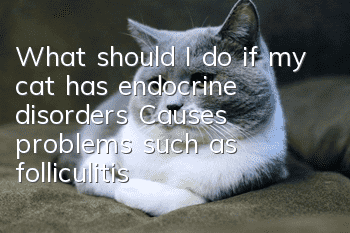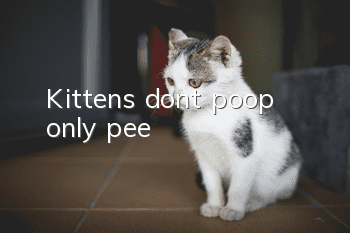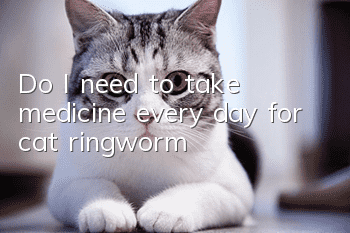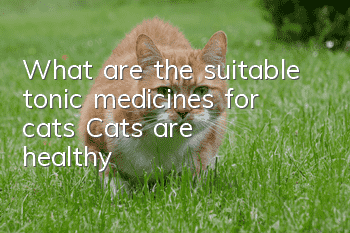What should I do if my cat has endocrine disorders? Causes problems such as folliculitis, hair loss, and obesity

Endocrine is mostly related to the secretion of hormones in the body, and endocrine disorders are mostly caused by improper feeding and rearing, or by external stimulation, which causes stress in the body and causes endocrine abnormalities. Endocrine disorders may also cause Cause some inflammation. Generally speaking, our common endocrine disorders, such as acne and internal heat in humans, are symptoms such as folliculitis and hair loss in cats. Other serious diseases may cause diabetes and thyroid and adrenal gland abnormalities.
Let’s first look at the problem of folliculitis. Feline folliculitis, also known as feline acne, is caused by overnutrition or endocrine disorders. It is common in cats that eat cat food that is very oily and high in meat. It manifests as many small black spots on the chin, like cinders, and it also occurs at the root of the tail of some cats. The root of the tail always looks dirty, as if it cannot be washed clean. Black spots on a cat's chin are not contagious, just like blackheads on a human nose. It doesn’t matter if you have a few black spots on your chin. If it becomes inflamed, hair loss, moist or smelly, it’s called folliculitis and needs treatment. The same goes for the tail. There are tail fat glands on the tail. If they are blocked, they will become inflamed. In severe cases, they may become pus-filled. Folliculitis on the tail is more common in male cats than in female cats. Most cats get better after neutering, but a few cats still have it after neutering. Sometimes folliculitis also occurs on the nipples.
To solve folliculitis, you must first change the food to a lighter food for the cat, and then apply some external medicine. If you cannot buy special medicine for pets, you can first use green tea or light salt water alcohol to clean the cat, and then Apply erythromycin ointment. If it is folliculitis that grows on the tail, that is, ponytail, it is best to shave the hair on the tail and then apply medicine, otherwise it will be difficult to cure.
Next is cat hair loss. There are many reasons for hair loss. Hair loss when infected by some microbial parasites will make the skin red and swollen, with symptoms of infection. Hair loss caused by endocrine disorders is often simple hair loss. In Hyperadrenocorticism, hypothyroidism, excessive secretion of male hormones, and ovarian cysts in female cats can all cause hair loss in cats. As a parent, if you find that your cat is shedding a lot of hair when it no longer sheds, you should be alert to whether the hair loss is caused by endocrine disorders.
It is worth noting that the replacement of some cat food can also cause endocrine disorders in cats. This is related to the cat's own adaptation. Being acclimatized can also cause functional disorders and lead to endocrine disorders. Some cat food ingredients are not good for some cats. It is very sensitive, just like some people can eat spicy food, but some people cannot eat it and get acne when they eat it. Some cat foods can also cause endocrine disorders for specific cats. We often see others saying that that brand of cat food is good. Then I changed the food. As a result, my cat developed folliculitis or lost hair after eating it. Therefore, changing cat food is a big problem in feeding. You should change cat food slowly. It is different from the previous cat food. Changing them in conjunction with each other is good for the cat's adaptation.
Finally, let’s talk about the issue of obesity. Cat obesity is also caused by endocrine disorders and is related to some hormones. For example, acromegaly in cats is related to growth hormone. Elderly cats are prone to acromegaly, but this is generally pathological. Cat's hypertrophy is easier to detect. Cat's natural obesity is actually more dangerous. If the owner just ignores it, the cat may develop diabetes.
Some organizations have conducted surveys, showing that more than 80% of pets are overweight. Among these overweight pets, half are obese and 20% are overweight. If a person is overweight, it will bring a series of health risks, and the same is true for pet obesity. Obesity in pets can easily lead to endocrine disorders, and the chances of developing diabetes, arthritis, heart disease, and liver disease are much higher than in normal pets. Moreover, the older you get, the more likely you are to contract diseases due to obesity.
There are generally two ways to judge cat obesity. One is observation. Under normal circumstances, you can feel the cat’s ribs, and there is no obvious fat layer on the ribs. Furthermore, when the pet is squatting, if the weight is normal, the waist and hips should be clear. The other is to make a judgment by comparing the weight standards of cats of different breeds with your own pets.
If a cat gets diabetes due to obesity, then treatment is not a matter of one or two days. In the early stage of diabetes, the cat will eat a lot, drink a lot, urinate a lot, lose weight quickly, and in the middle and later stages, the cat will be physically weak, listless, eat less or not eat enough. Food. Diabetes requires intravenous drip supplementation or promotion of excretion to achieve the purpose of regulating various electrolytes in the body. Through small-dose insulin injections and long-term blood sugar observation, we can understand the cat’s response cycle to insulin and conduct regular follow-up visits. Cats suffering from diabetes mean a long time. Insulin injections are required for a period of time or even for life. However, there are many cases showing that cats have the function of self-recovery. After several years of treatment, they can restore insulin secretion and achieve self-healing.
Therefore, in order to prevent diabetes, pet owners should pay attention to scientific feeding. It is not advisable to feed them leftovers, leftovers, and high-calorie cakes, meat, and bones without restraint. You should feed more low-fat and high-fiber foods. It is best to allow your pet to maintain moderate-intensity exercise for about half an hour every day. For obese pets, you can help them diet appropriately.
- Cats tremble while sleeping
- The cat's tail does not move, but the tip of the tail moves
- How to teach a cat to be alone when the owner is not at home? Cat training!
- Radiographic signs of cat joint disease, the disease makes cats miserable!
- Does your British Shorthair cat have these bad habits?
- How to treat postpartum calcium deficiency in cats?
- What are the signs of a Chinchilla cat in heat?
- Why do I drool when I touch a cat?
- What should you pay attention to when breeding cats?
- Common oral disease symptoms and treatments in cats



